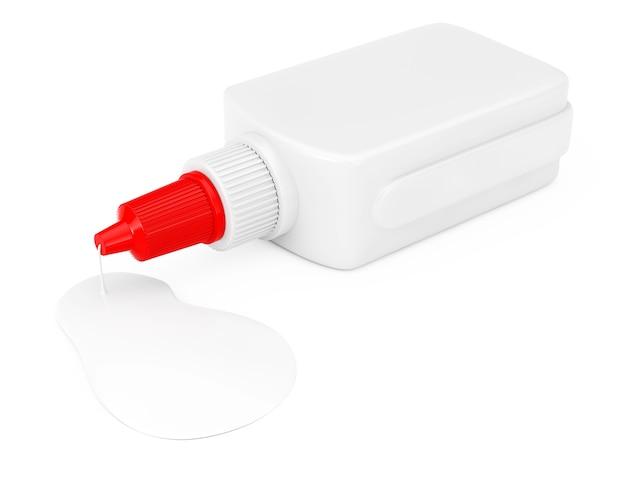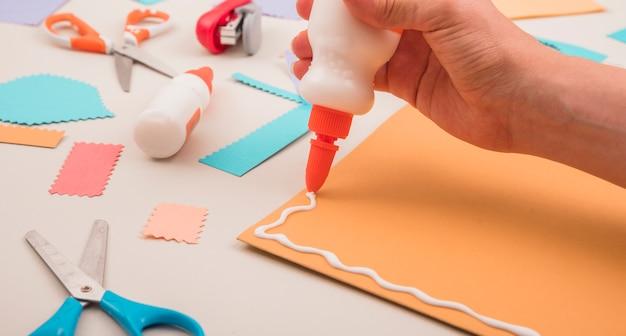Exploring the world of crafts and DIY projects often involves a crucial tool – glue. From kindergarten classrooms to seasoned artisans’ workshops, glue acts as the invisible hero that binds creativity together. One popular type of glue that comes to mind is white glue. But have you ever wondered what exactly white glue is made of?
In this blog post, we’ll delve deep into the ingredients that make up white glue, debunk common misconceptions, and answer burning questions. So, whether you’re a curious crafter or simply intrigued by the science behind everyday products, read on to unravel the mysteries behind white glue. Let’s quench your curiosity and gain a deeper understanding of this adhesive superstar!
What Makes White Glue So Sticky
We all know the feeling of getting our hands stuck together with white glue. It’s like a sticky situation waiting to happen. But have you ever wondered what exactly makes white glue so adhesive? Let’s dive into the fascinating world of glue chemistry and find out what this magical substance is made of.
The Ingredients: A Sticky Lineup
White glue, also known as PVA glue (polyvinyl acetate), might seem like a humble household product, but its composition is anything but basic. This versatile adhesive is primarily composed of three key ingredients: water, PVA resin, and a handful of additives.
PVA Resin: The Glue’s Secret Weapon
At the heart of white glue lies the powerful PVA resin. This synthetic polymer acts as the glue’s backbone, providing the stickiness that we all rely on. Derived from petroleum, PVA resin undergoes a series of chemical reactions to create a glue that can hold various materials together.
Water: The Lubricant that Keeps Things Flowing
Water might seem like an odd addition to a sticky substance, but it plays a crucial role in the glue-making process. Water acts as a lubricant, making it easier for the PVA resin to mix with other ingredients and form a smooth, spreadable consistency. Moreover, water acts as a carrier, helping the glue dry and form a strong bond.
Additives: Enhancing Stickiness and Shelf Life
To give white glue some extra oomph, manufacturers often add a few secret ingredients to the mix. These additives can include preservatives to extend the glue’s shelf life, plasticizers for flexibility, and fillers to improve the glue’s overall performance.
The Science Behind Stickiness
Now that we know what white glue is made of, let’s take a peek at the science behind its remarkable stickiness. When white glue is applied to a surface, it initially appears wet and runny. As the water begins to evaporate, the PVA resin molecules gradually link together, forming a strong bond between the two surfaces.
This bonding process, known as cross-linking, creates a network of interconnected PVA chains. The more PVA chains that form, the stronger and stickier the bond becomes. So, the next time you find yourself stuck thanks to white glue, you can thank the magical chemistry of cross-linking for that adhesive grip!
Why White Glue Is Ideal for Crafters and DIY Enthusiasts
White glue has gained popularity over the years for many reasons. Its non-toxic nature makes it safe for use by crafters of all ages, and its water-soluble formula means easy cleanup. Plus, its versatility allows it to bond a wide range of materials, from paper and fabric to wood and ceramics.
With its affordable price tag and widespread availability, white glue has become a staple in every crafter’s toolbox. So, the next time you embark on a DIY project or unleash your creativity, don’t forget to reach for that trusty bottle of white glue!
White glue may seem like a simple adhesive, but its composition and chemistry are more fascinating than meets the eye. With a strong backbone of PVA resin, the lubricating power of water, and a touch of secret additives, white glue possesses the magic needed to get things stuck together. So, the next time you’re in a sticky situation, remember the incredible science that holds it all together!
FAQ: What’s White Glue Made Of
Welcome to our comprehensive FAQ-style guide to the world of white glue! We’ve got the answers to all your burning questions about this sticky substance. Let’s dive in and uncover the secrets behind white glue, its composition, and the differences between various types of glue.
What is the white glue made of
While the exact formulation can vary between manufacturers, most white glue is primarily composed of a substance called polyvinyl acetate (PVA). This polymer is water-based and non-toxic, making it safe for a wide range of applications. So rest assured, you won’t be stuck with any mysterious or hazardous ingredients.
Is white glue made from horses
No, white glue is not made from horses. This popular misconception probably comes from the fact that some adhesives, like animal glue, used to be made from animal byproducts. However, modern white glue, including the famous Elmer’s Glue, is entirely synthetic and does not involve any equine ingredients.
What’s the difference between school glue and white glue
Here’s the scoop: white glue and school glue are essentially the same thing! The terms “school glue” and “white glue” are often used interchangeably to refer to PVA-based adhesives. So whether you’re a crafting enthusiast or a student working on a project, both options will work equally well for your gluing needs.
Can you eat glue
While we don’t recommend making glue a part of your daily diet, most traditional white glue varieties are non-toxic. However, that doesn’t mean it’s suitable for consumption. The adhesive properties and thickening agents in glue can cause digestive issues if ingested. So stick to using glue for its intended purpose—sticking things together, not serving as a questionable snack!
How do you make white glue
Ah, the secret recipe for white glue! Although we can’t disclose the precise details, white glue consists of a mixture that usually includes polyvinyl acetate dispersion, water, preservatives, and stabilizers. When these components come together in just the right proportions, you get that familiar, gooey substance that is oh-so-versatile.
Is Gorilla Glue stronger than PVA
Indeed, Gorilla Glue is known for its incredible strength and bonding capabilities. However, it’s important to note that Gorilla Glue and PVA glue serve different purposes and have different compositions. Gorilla Glue is a polyurethane-based adhesive, while PVA glue, including white glue, is based on polyvinyl acetate. Each glue has its own unique set of properties, so the ideal choice depends on your specific project.
Why is there a cow on Elmer’s glue
Ah, yes, the iconic cow on the Elmer’s Glue label. This beloved bovine has become a symbol of the brand’s long-standing heritage. Elmer, the cow, is a playful homage to Elmer W. Bond, the son of the company’s founder. The cow’s presence adds a touch of whimsy to what might otherwise be a rather mundane bottle of glue.
What is the strongest glue in the world
In the world of adhesives, many contenders vie for the title of “strongest glue.” Among them is cyanoacrylate-based super glue, which forms an incredibly strong bond in a matter of seconds. Epoxy resin glue is another heavyweight, famous for its exceptional durability and ability to bond a wide range of materials. So, if you’re in need of sheer strength, these glues might just be your best bet.
Is PVA glue the same as school glue
Absolutely! PVA glue and school glue are synonymous terms. PVA stands for polyvinyl acetate, which is the main component of white glue or school glue. So whether you’re grabbing a bottle labelled PVA or school glue, you’re getting the same sticky substance beloved by teachers, students, and craft enthusiasts alike.
Is Mod Podge better than PVA
When it comes to choosing between Mod Podge and PVA glue, it all boils down to your project’s requirements. Mod Podge is a specific brand of decoupage medium that combines PVA glue with other elements like varnish or sealant. It offers additional features such as waterproofing or a matte or glossy finish. So, whether Mod Podge is better than plain PVA depends on the specific effects you’re aiming for.
What is the difference between white glue and wood glue
Both white glue and wood glue fall under the umbrella of PVA-based adhesives. The primary difference lies in their formulation and intended use. Wood glue, as the name suggests, is specially designed for bonding wood surfaces. It typically has a higher viscosity and longer drying time compared to regular white glue, allowing for a stronger hold on wood joints. So if you’re working on a woodworking project, reach for the wood glue!
What is the difference between white and clear PVA glue
The difference between white and clear PVA glue lies primarily in their appearance. White PVA glue tends to dry to a translucent, white finish, making it ideal for applications where the adhesive won’t be visible. Clear PVA glue, on the other hand, dries completely transparent, making it a fantastic choice for projects where aesthetics matter. Other than the color, their basic composition and functionality are the same.
Now that you’re armed with the knowledge of white glue, its ingredients, and the differences between various types, you can tackle your gluing endeavors with confidence. So go forth, create, and stick things together like a true glue master!

